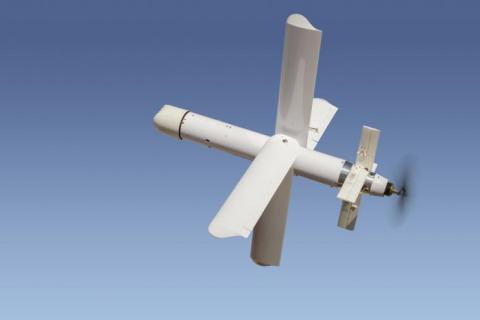"Loitering UAVs are Precision-Guided Missiles"
The loitering attack munition designated "Hero" has been developed in several versions, to be employed according to the size of the target and the manner in which the platform should be used. The smaller attack munition weighs 3 kg only and the weight of its warhead is about one third of the total weight. It is fitted with a battery that weighs 1 kg. The Micro-Stamp payload by Controp of Israel, weighing 300 grams only, is fitted to the head of the UAV. This payload enables daytime and night video surveillance with the images transmitted to the operators in the rear area. The UAV may be used for surveillance and intelligence collection missions. All strike missions may be aborted until the very last moment and the UAV may be retrieved with landing accomplished by the means of a parachute.
UVision's CEO is Yair Dubester, one of the pioneers of the Israeli UAV industry, who served as the manager of MALAT, IAI's UAV division. UVision is a privately-owned company. Following a change of ownership a few years ago, the Company also revised its business and technology focus.
"In our new incarnation, we decided to focus on loitering attack munitions," reveals Dubester. "Our view – and we have seen the Americans adopting the same view – is that loitering attack munitions are going to be the next big thing. I am not referring to such large 'Kamikaze' UAVs as IAI's Harop, but to smaller, 'personal' loitering munitions. The Americans began using such platforms in Afghanistan."
The Chairman of UVision's Board of Directors is former IDF Deputy Chief of Staff Maj. Gen. (res.) Yair Naveh. According to him, "We carried out a structured analysis of the coming decade and realized that the future is, indeed, in loitering attack munitions. Most of the Western world will be compelled to cope with terrorism and guerrilla warfare. The combat zones are densely-populated areas where it is difficult to distinguish between combatants and uninvolved parties. The loitering munition enables you to approach the target until you make the actual decision to attack, and then perform the attack with maximum accuracy if no damage to uninvolved parties is expected.
"Additionally, we understand that the targets must be dealt with in real time, and the number and value of the targets are increasing. The enemy employs various measures in order to disrupt the attack capabilities of Western weapon systems, so we must be one generation ahead of the enemy's capabilities."
According to Naveh, "The idea is to provide the company and platoon levels with a UAV that enables surveillance, fire cycle closure and hitting the target. The price is one of the outstanding advantages. We have placed on the table, for the first time ever, a product from the missile ordnance world at prices that are not the usual prices charged for missiles."
The various models of the Hero UAV are intended for use against personnel targets, buildings or armored vehicles. The UAV knows how to spot the weak spots of a vehicle or a building and penetrate through them, and is also suitable for attacking anti-aircraft batteries.
The Hero UAV is launched by a pneumatic launcher that utilizes air pressure only, so it does not produce a flash that might betray the location of the launching force and endanger it.
The "Kamikaze" UAVs – the larger models in the Hero series – are powered by gasoline engines and have extremely long ranges. The Hero UAVs have already been presented to several foreign armed forces, including the US military. "The battlefield is changing and so does the ordnance," says Maj. Gen. (res.) Yair Naveh.
Amir Rapaport

